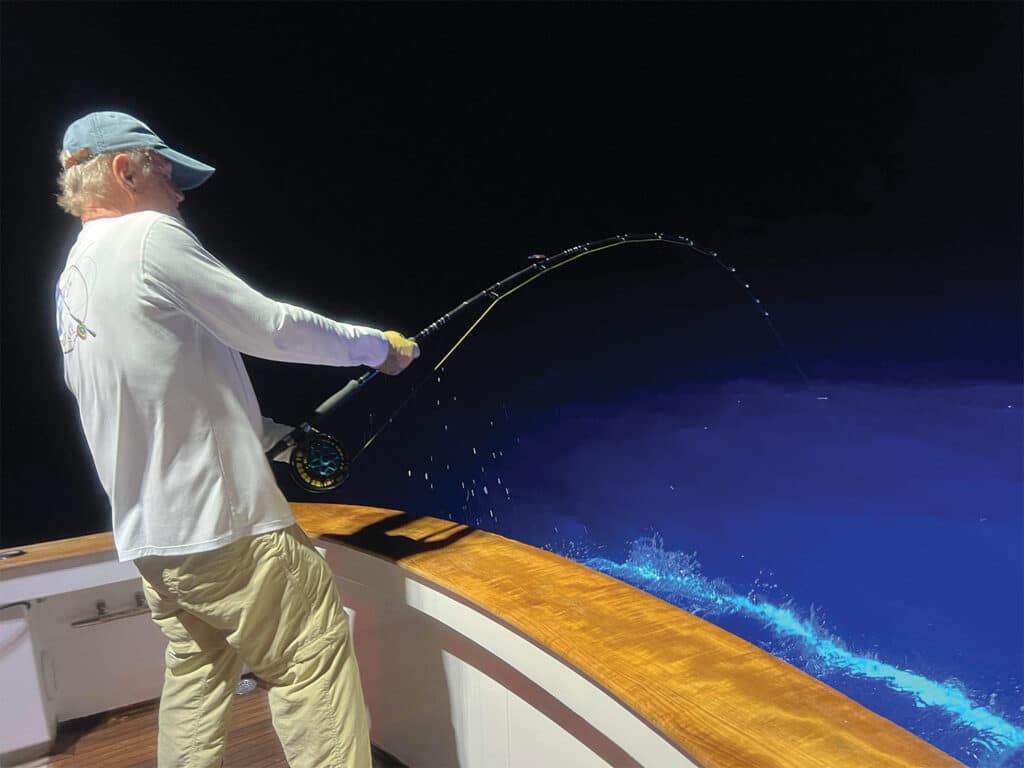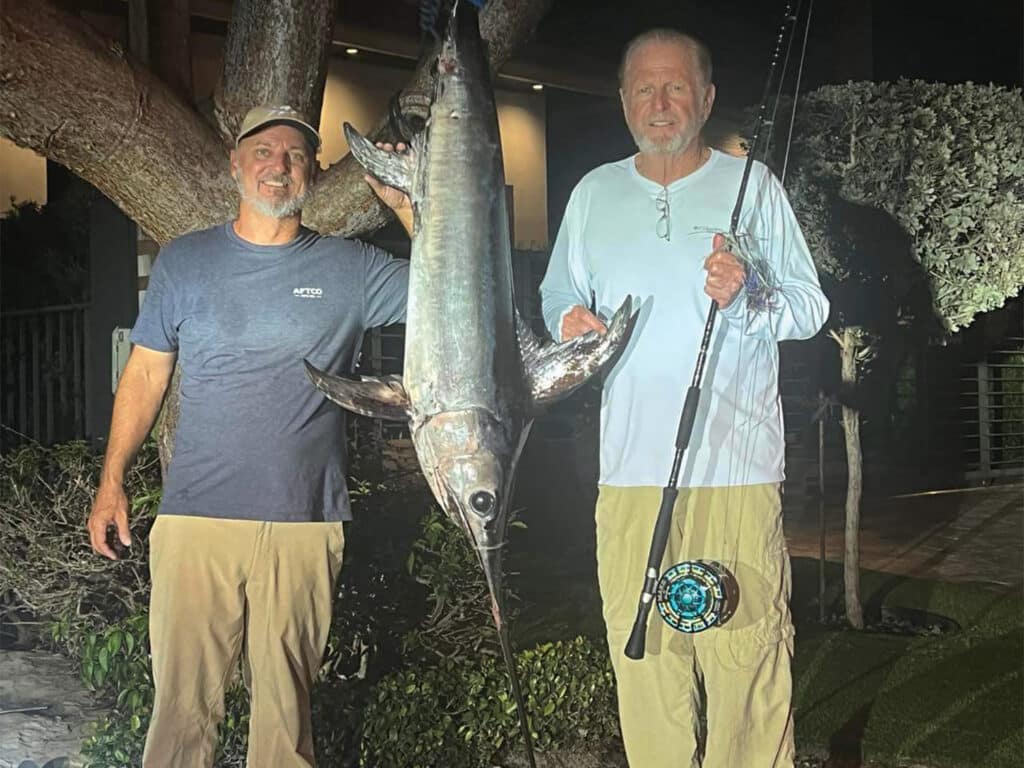
Special delivery: Sign up for the free Marlin email newsletter. Subscribe to Marlin magazine and get a year of highly collectible, keepsake editions – plus access to the digital edition and archives.
As we ran out to the sailfish grounds off Isla Mujeres, Mexico, some 25 years ago, my good friend Capt. Chucho Manzano said, “There are those of us that are born to be fishing souls.” I was born to be one such soul, and the sport of fishing—with its countless journeys and challenges—has been a dominant force in my life since I was three years old. I’ve always been one to chase a challenge, so when the IGFA first unveiled its enhanced recognition program, which celebrates anglers and their accomplishments with various lifetime achievement awards, I found myself in pursuit of a new goal: the Billfish Royal Slam.
To earn a spot in the Billfish Royal Slam Club, an angler must catch all nine recognized species of billfish. It’s no easy feat, but I was lucky enough to get it done many years ago. After capturing my first Royal Slam, I yearned for a new challenge. I’d later find it on the fly. By 1990, I shifted my focus to fly-fishing for sailfish. I was a member of the Miami Rod and Reel Club and each year received the Judge Merkens Memorial Award for catching and releasing sailfish on fly. I even once held the world record for Atlantic sailfish on 12-pound-test fly tippet.
I then started fishing in Venezuela, where I had great fun catching white marlin on fly with Capt. Bubba Carter and other great captains. We even tangled with a few blue marlin, but were never able to successfully catch one. Later, with the help of Capt. Jake Jordan, I learned the new equipment and techniques I’d need to capture my first blue marlin on 20-pound-test fly tippet. This opened an entirely new world of fishing.
In November 2017, my captain at the time, Corey Hexter, and I decided to try to capture a swordfish on IGFA regulation fly tackle aboard my boat, Gladiator. Marty Arostegui and Capt. Bouncer Smith had already been able to do it, so we figured there was no reason we couldn’t also achieve this goal. Little did Hexter and I know that we were about to embark on a journey several years in the making. The first thing we had to do was figure out how to raise a deep-water, nocturnal feeder with a teaser. Our initial attempts were frustrating at best. Eventually we raised a small juvenile sword. As the fish came into the light behind the boat, we noticed that it swam in a crazy figure-eight pattern around the fly but never bit.

After this show, I reached out to Dr. David Kerstetter, who at the time was at Nova Southeastern University and had been studying the species for years. He said he had also witnessed this behavior and thought it was because the light was bouncing around in the fish’s giant eye, confusing the animal. I also reached out to Kenya’s Jeremy Block, who not only held the current world record, but was one of just two anglers recognized by the IGFA for capturing a swordfish on fly, the other being Morocco’s Fouad Sahiaoui. Block and I hit it off immediately, and he was very open with me about his experiences and knowledge. He taught me that we should turn off our lights, and to be patient if we were to raise one. He explained that it was important that we avoid moving away too soon after it appeared that the fish had faded away, since it may still be hanging out under the boat.
The next thing we had to do was determine just where the productive fishing grounds were to help us increase numbers. There were some very quiet stretches when we never saw a fish, some as long as 13 nights without a bite. But it was just a matter of time. Soon we found our own turf that we felt was producing decent opportunities to raise swords.
Another important part of the equation was our teasers and flies, and how to present them to entice a bite. We tried all sorts of variations on our flies, including assorted colors and shapes, double hooks, large and small single hooks, and even circle hooks. It took us about a year and a half to master the basics before we started hooking swords on a fly rod. Then another challenge presented itself. Swordfish approach their prey like no other species any of us had ever caught. We could raise them, and get them to come at the fly on the switch, but hooking them in the mouth was a whole different story. Almost all the fish we have hooked in the last seven years have pulled the hook. Their eating behavior causes them—we believe—to get hooked in the soft flesh of their cheeks. We’ve had some bigger fish on and even been spooled with 400 yards of backing, yet we have hardly ever broken a tippet.
The weather was—and still is—another problem. We sometimes wait for weeks in order to have weather suitable to fly-fish at night for swords. The wind direction, waves, current and moon phases are all factors in our planning. However, as the commercial buoy fishermen will tell you, swordfish bite in all conditions. Nevertheless, we’ve developed our own kind of formula to optimize our time on the water. Our milestone trip took place on March 9, 2024, with Capt. Tim Richardson at the helm and Capt. Eric Leech on the deck with me. We had already raised three swords to the transom when a fourth fish bit my fly and got firmly hooked in the top of his mouth. After a 20-minute fight, we were able to boat the fish.
Both Richardson and Leech agreed that this fish may be the one, but it would be close. With that, we cleaned up our spread and headed to shore to weigh the fish. At the dock, the fish measured 53 inches from the fork of its tail to the lower jaw, and its weight on an IGFA certified electronic scale came in at 59.4 pounds, a potential new world record on 20-pound-test fly tippet and more than four pounds heavier than the previous mark set by Block in Kenya.
Landing a swordfish on fly requires immense preparation. The IGFA has been an integral part of our team in that they pretest all the line we use for tippets. This gives us the confidence that if and when we have a potential world record, the line will test properly.
Read Next: How to Target Billfish on Fly.
This is my seventh season fishing for these deep-water predators, and in a good season we will spend more than 30 nights on our quest. During our previous best season, we captured two fish on fly—one in December and one in March. This allowed me two back-to-back Billfish Royal Slams on Fly.
The principal captains to date have been Hexter, Andrew Ford and now Richardson. And our primary mates have been Bryan Vaughn and Leech; however, many others have been part of the journey. I want to wholeheartedly thank everyone who helped me over the years to accomplish this world record, as well as the five other swordfish we have captured on fly. And we’re not stopping there. Next, we’re looking for that first 100-plus-pound swordfish on 20-pound-test tippet, or maybe even something lighter.







